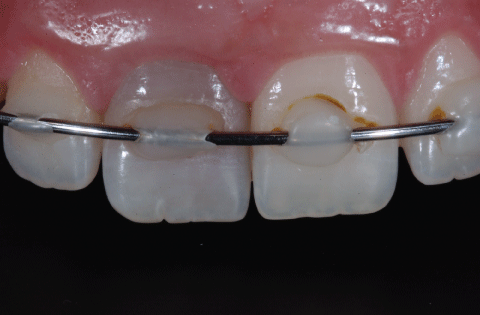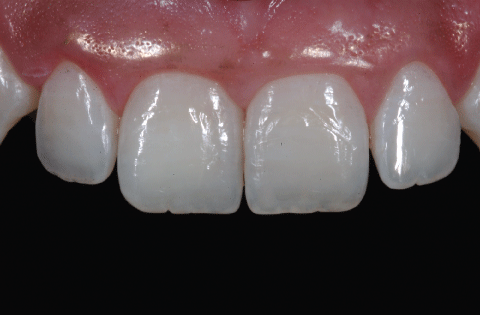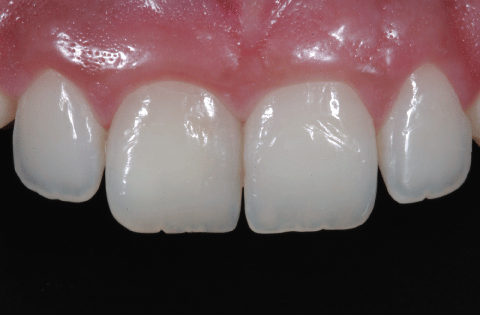International Journal of Oral and Dental Health
Combined Technique for Bleaching Non-Vital Teeth with 6-Month Clinical Follow-Up: Case Report
Ana Claudia Santos de Azevedo Izidoro1, Gislaine Cristine Martins1, Cristian Higashi1, Christiana Zander-Grande1, Lidia Yileng Tay1, João Carlos Gomes2, Nara Hellen Campanha2 and Janaina Habib Jorge3*
1Universidade Estadual de Ponta Grossa, Brazil
2Department of Dentistry, Universidade Estadual de Ponta Grossa - UEPG, Brazil
3Department of Dental Materials and Prosthodontics, Araraquara Dental School, UNESP - Univ Estadual Paulista, Brazil
*Corresponding author: Janaina Habib Jorge, Department of Dental Materials and Prosthodontics, Araraquara Dental School, UNESP - Univ Estadual Paulista, Araraquara, SP, Rua Humaitá, n°1680 Centro, Araraquara, São Paulo, CEP: 14801-903, Brazil, E-mail: janainahj@bol.com.br/janainahj@foar.unesp.br
Int J Oral Dent Health, IJODH-1-009, (Volume 1, Issue 2), Case Report; ISSN: 2469-5734
Received: April 25, 2015 | Accepted: June 20, 2015 | Published: June 23, 2015
Citation: Izidoro ACSA, Martins GC, Higashi C, Zander-Grande C, Tay LY, et al. (2015) Combined Technique for Bleaching Non-Vital Teeth with 6-Month Clinical Follow-Up: Case Report. Int J Oral Dent Health 1:009. 10.23937/2469-5734/1510009
Copyright: © 2015 Izidoro ACSA, et al. This is an open-access article distributed under the terms of the Creative Commons Attribution License, which permits unrestricted use, distribution, and reproduction in any medium, provided the original author and source are credited.
Abstract
Aim: The aim of this case report is to demonstrate the efficacy of the combination of two techniques of dental bleaching (inside and outside) to deal with the aesthetics of the smile.
Materials and methods: The intra-bucal examination showed the presence of a fistula in the vestibular region of the tooth 11 and a darkening of the tooth crown. It was performed root canal treatment and after completion, the process of internal bleaching using sodium perborate with hydrogen peroxide 20% ("walking bleach" technique) was applied. External dental bleaching as a complement of the tooth 11 was performed to correct a persisted color change after the completion of internal bleaching. After the bleaching procedure, neutral fluoride was applied for 60 seconds and the surface of the enamel was polished.
Conclusion: It was concluded that through the combination of the techniques of dental bleaching is possible to solve the unsightly problem of a non-vital darkened tooth and also achieve the result desired by the patient.
Keywords
Tooth bleaching, Esthetics dental, Hydrogen peroxide
Introduction
Tooth discoloration can be intrinsic, extrinsic or a combination of both. The discoloration is caused by the incorporation of intrinsic chromatogenic material into the dentin and enamel during odontogenesis or after teeth eruption [1,2]. The causes of intrinsic discoloration in the pre-eruption are the administration of tetracycline, exposure to high levels of fluoride, trauma to the developing tooth, in addition to hereditary diseases such as amelogenesis imperfecta and dentinogenesis, and congenital erythropoietic porphyria [3].
After dental eruption, the main causes of discoloration are pulp necrosis, deposition of blood components into the tubules after trauma or pulpectomy, and deposition of secondary dentin due to aging or iatrogenic injuries [3,4]. Food and beverages such as coffee, tea, red wine, carrots, oranges and tobacco are primarily responsible for giving rise to extrinsic stains [1,4].
Dental bleaching offers a solution for conservative and aesthetic problems instead of invasive repair options, such as crowns or porcelain veneers. Different protocols have been proposed for bleaching non-vital teeth, [3,5] where the main bleaching technique for these clinical situations involves placing oxidizing agents inside the pulp chamber in direct contact with the dentin, it's called inside bleaching [6]. Several substances have been used, such as oxalic acid, sodium hypochlorite, aluminum chloride, acetic acid, hydrogen peroxide, sodium perborate and carbamide peroxide [3,6-11]. The thermocatalytic inside bleaching technique involves the placement of chemical oxidants in the pulp chamber, which can be activated by different heat sources in order to accelerate the whitening process [12].
Although this technique is effective, it was abandoned due to excessive heat, which may be responsible for the appearance of external cervical resorption [13]. It has been hypothesized that hydrogen peroxide penetrating through open dentin tubules can initiate an inflammatory reaction which could result in root resorption. The use of "buffer ionomer" at the entrance of the root canal has been recommended in internal dental bleaching in order to minimize the occurrence of external resorption [2,5,13]. The walking bleach technique is an approach that uses no heat. This technique involves placing an active ingredient (such as 37% carbamide peroxide, sodium perborate or sodium perborate combined with 5-35% hydrogen peroxide) within the pulp chamber, followed by sealing the cavity [14]. The whitening process occurs between sessions, while the bleaching agents are sealed into the pulp chamber. Depending on the etiology of the discoloration, a satisfactory reduction must occur within three to six sessions [10].
Few reports have been published of the walking bleach technique associated with the protocol of external bleaching [5,15,16]. Thus, the purpose of this paper is to report through a case study, the combination of inside bleaching carried out with sodium perborate in combination with 20% hydrogen peroxide (endogenous technical) with the outside bleaching technique using 35% hydrogen peroxide (exogenous technical).
Case Report
A 24 year-old man attended the State University of Ponta Grossa's clinic reporting trauma of the tooth 11 three months ago. He suffered trauma during a football game, which caused tooth mobility and gingival bleeding. Due to pain and tooth mobility, he went to an emergency dental service where pulp cavity access and splint of the tooth was performed (Figure 1), which remained for three consecutive months because the patient stopped treatment. Clinical examination showed the presence of a fistula in the vestibular region of tooth 11 (Figure 2) and darkening of the tooth crown (Figure 3). As a treatment plan it was decided to remove the splint and finish the endodontic treatment in three sessions (Figure 4). Patient signed an informed written consent before the procedures.
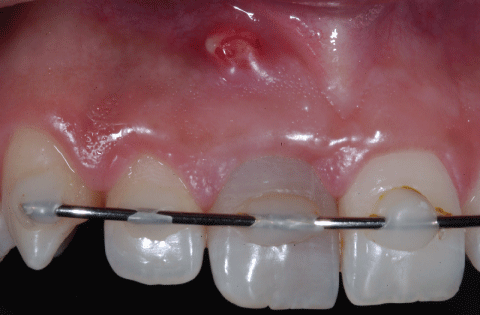
.
Figure 2: Presence of fistula in the periapical region due to necrosis of the tooth 11
View Figure 2
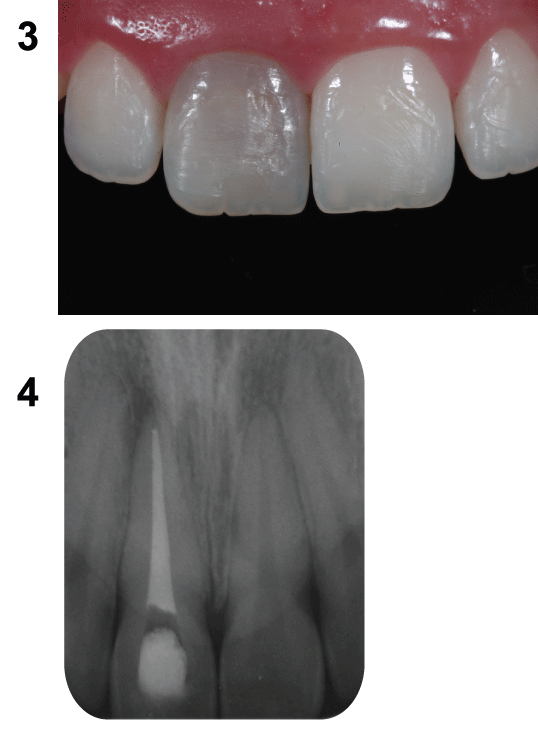
.
Figures 3&4: Clinical and radiographic view of tooth 11 after endodontic treatment
View Figures 3&4
One week after endodontic treatment conclusion, began the process of internal bleaching using powder of sodium perborate with 20% liquid hydrogen peroxide (Whiteness perborate, FGM, Joinville, SC, Brazil). After removing the temporary restoration, the original color was recorded and then the gutta-percha was removed approximately 2mm from the cement-enamel junction in the apical direction. A millimeter explorer and radiographs were used to demonstrate the depth of the removal. In this space, it was inserted a layer of glass ionomer (R Maxxion, FGM, Joinville, SC, Brazil) to seal the dentin tubules of the root canal, avoiding the contact of the sodium perborate with this region. Because the cement-enamel junction is more coronal on the proximal surfaces than on the buccal and lingual, ionomer layer was placed more coronally on the proximais walls [5]. The bleaching agent was replaced twice, until obtain the desired color, with intervals of one week between each session. Subsequently, the cavity was washed thoroughly and filled with glass ionomer (R Maxxion, FGM, Joinville, SC, Brazil).
After one week was performed complementation with external dental bleaching of the tooth 11 to correct the minimal persistent color change even after the completion of internal bleaching. This procedure involves gingival isolation with Top Dam (FGM, Joinville, SC, Brazil) which was light cured for 30 seconds. Then the gel Whiteness HP Maxx (FGM, Joinville, SC, Brazil) was applied for 15 minutes, this procedure was performed three times in one session (Figure 5). It was concluded that the bleaching procedure with enamel polish and neutral fluoride application for 60 seconds.
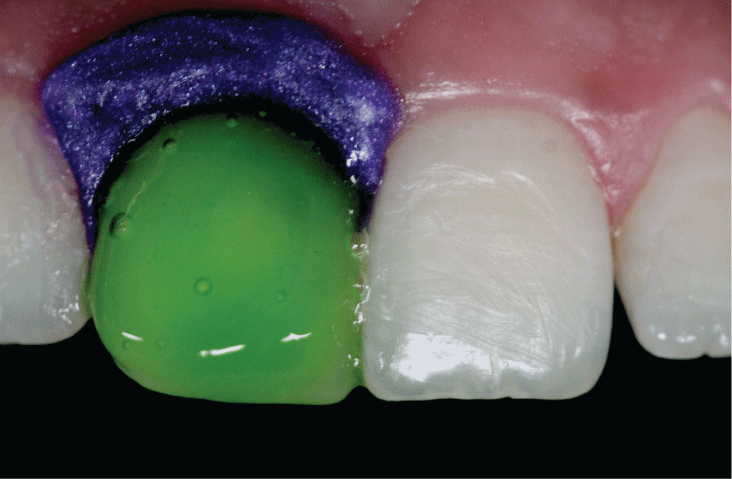
.
Figure 5: External dental bleaching done to improve a persistent slight darkening after bleaching procedure
View Figure 5
Finally, with a golden powder, the remnants of resins used for splinting the anterior teeth were removed (Figure 6) and the enamel surface was polished with the aim of regularizing scratched surfaces during the splint removal. The excellent immediate outcome can be observed in figure 7, and after six months we can observe a slight recurrence of the darkening in figure 8, but the aesthetic result is still very satisfactory.
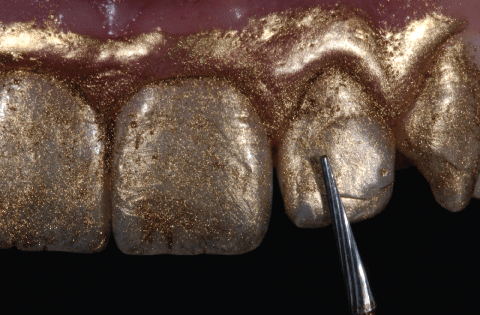
.
Figure 6: Use of a golden powder to remove the remaining resin in the teeth that were splinted
View Figure 6
Discussion
Before choosing the material and technique for internal dental bleaching, you should consider the amount of remaining tooth structure, quality of root canal treatment and health of periodontal tissues [16]. The tooth of the clinical case reported in this paper presented all the necessary requirements for the indication of internal bleaching, as a good quality of endodontic treatment, a large amount of tooth structure and root internal walls intact.
Bleaching techniques should consider the biological and clinical safety [17]. Biological security is related to the concentration of the product and the time of application, clinical security is related with the adverse effects that may occur such as irritation of soft tissues, changes in enamel hardness and dentin permeability [17,18].
The use of 30% hydrogen peroxide associated to sodium perborate was introduced in 1967 by Nutting and Poe, [14] this technique was denominated "walking bleach". According to these authors, this combination would be more effective than sodium perborate associated with water. However, the effectiveness and the damage caused by bleaching have been discussed, particularly the external resorption [2].
In injured teeth, bleaching techniques that uses less caustic substances (hydrogen peroxide at low concentrations, or even water associated with sodium perborate) should be used, instead of using 35% hydrogen peroxide associated with heat (thermocatalytic technique) [19]. The material in this case (sodium perborate with hydrogen peroxide 20%) has a lower concentration of hydrogen peroxide, and therefore it is less aggressive.
To avoid the occurrence of external resorption, different techniques and materials have been proposed [3,20]. The most often cited solutions in literature are putting a "buffer" of glass ionomer at the root canal's entrance, [15-20] the careful choice of the bleaching agent and filling the pulp chamber with calcium hydroxide after obtaining the desired color [3,5,20].
The "ionomer buffer" placed at the entrance of the root canal has been advocated by several authors [2,13,21]. Its function is to reduce the penetration of hydrogen peroxide into the dentin tubules, thus minimizing the possibility of external resorption [5]. The indication of calcium hydroxide placement into the pulp chamber after bleaching procedure is based on its buffer capacity. It is believed that it is able to stabilize the acidic pH promoted by hydrogen peroxide, preventing the occurrence of root resorption [22].
Often to get the desired aesthetics in vital teeth, it is necessary the combination of two techniques, for example, external bleaching done in office and home bleaching [23,24]. Likewise, in some cases, non-vital teeth can be bleached with the combination of two techniques: internal bleaching ("walking bleach") and external bleaching in office [16]. Actually, there are few reports in the literature about the benefits of this association [5,15,25]. Its principal advantage is the quickness of the result [5,26] and the less possibility of external root resorption compared with the thermocatalytic technique.
External dental bleaching has some adverse effects as tooth sensitivity, gingival irritation and in some cases, reversible pulpitis [23,27,28]. In the case of non-vital teeth such effects do not occur, but if the technique is not well developed, root resorption or external resorption may occur [20,29,30], although it is more frequently observed in teeth treated with the thermocatalytic technique [3,16,29]. According to Howell, the technique of non-vital bleaching has an immediate success rate of 89.5% [31]. However, there is the possibility of recurrence of discoloration, meaning that the result cannot be considered permanent. Many authors evaluated the recurrence of darkening in six years after the bleaching procedure and reported different percentages of recurrence [31,33]. While some articles have reported a success rate of 75% or more after five years, others report a success rate of only 45% after six years [32-34]. This results shows that a completely stable outcome seems to be very difficult to obtain, however, in cases of re-darkening, a re-treatment can be performed [16].
In this case, a slight darkening can be observed after 6 months of follow up (Figure 8), but the aesthetic result is still satisfactory. Within the aesthetic possibilities for resolution of the case it was opted for tooth whitening. Dental bleaching offers a solution for conservative and aesthetic problems instead of invasive repair options. Bleaching may be responsible for the arising of external cervical resorption, which may require monitoring.
Conclusion
With the case report presented and following all the indications and contraindications of the techniques used, it was possible, through the association of dental whitening techniques, to solve the unsightly problem of the patient and achieve the result desired by him immediately and after 6 months follow-up.
References
-
Hattab FN, Qudeimat MA, al-Rimawi HS (1999) Dental discoloration: an overview. J Esthet Dent 11: 291-310.
-
Valera MC, Camargo CH, Carvalho CA, de Oliveira LD, Camargo SE, et al. (2009) Effectiveness of carbamide peroxide and sodium perborate in non-vital discolored teeth. J Appl Oral Sci 17: 254-261.
-
Attin T, Paqué F, Ajam F, Lennon AM (2003) Review of the current status of tooth whitening with the walking bleach technique. Int Endod J 36: 313-329.
-
Watts A, Addy M (2001) Tooth discolouration and staining: a review of the literature. Br Dent J 190: 309-316.
-
Higashi C, Rauski RD, Gomes JC, Loguercio AD, Reis A (2007) One-year follow-up of non-vital discolored teeth after bleaching with an association of techniques: a case report. Gen Dent 55: 676-682.
-
Chng HK, Ramli HN, Yap AU, Lim CT (2005) Effect of hydrogen peroxide on intertubular dentine. J Dent 33: 363-369.
-
Bentley CD, Leonard RH, Crawford JJ (2000) Effect of whitening agents containing carbamide peroxide on cariogenic bacteria. J Esthet Dent 12: 33-37.
-
Caughman WF, Frazier KB, Haywood VB (1999) Carbamide peroxide whitening of nonvital single discolored teeth: case reports. Quintessence Int 30: 155-161.
-
Deliperi S (2008) Clinical evaluation of nonvital tooth whitening and composite resin restorations: five-year results. Eur J Esthet Dent 3: 148-159.
-
Dietschi D (2006) Nonvital bleaching: general considerations and report of two failure cases. Eur J Esthet Dent 1: 52-61.
-
Demarco FF, Meireles SS, Masotti AS (2009) Over-the-counter whitening agents: a concise review. Braz Oral Res 23: 64-70.
-
Buchalla W, Attin T (2007) External bleaching therapy with activation by heat, light or laser--a systematic review. Dent Mater 23: 586-596.
-
MacIsaac AM, Hoen CM (1994) Intracoronal bleaching: concerns and considerations. J Can Dent Assoc 60: 57-64.
-
Nutting EB, Poe GS (1967) Chemical bleaching of discolored endodontically treated teeth. Dent Clin North Am.
-
Poyser NJ, Kelleher MG, Briggs PF (2004) Managing discoloured non-vital teeth: the inside/outside bleaching technique. Dent Update 31: 204-210.
-
Dahl JE, Pallesen U (2003) Tooth bleaching--a critical review of the biological aspects. Crit Rev Oral Biol Med 14: 292-304.
-
Perdigão J, Francci C, Swift EJ Jr, Ambrose WW, Lopes M (1998) Ultra-morphological study of the interaction of dental adhesives with carbamide peroxide-bleached enamel. Am J Dent 11: 291-301.
-
Cavalli V, Giannini M, Carvalho RM (2004) Effect of carbamide peroxide bleaching agents on tensile strength of human enamel. Dent Mater 20: 733-739.
-
Loguercio AD, Souza D, Floor AS, Mesko M, Barbosa AN, et al. (2002) Clinical evaluation of external radicular resorption in non-vital teeth submitted to bleaching Pesqui Odontol Bras 16: 131-135.
-
de Oliveira LD, Carvalho CA, Hilgert E, Bondioli IR, de Araújo MA, et al. (2003) Sealing evaluation of the cervical base in intracoronal bleaching. Dent Traumatol 19: 309-313.
-
Joiner A (2006) The bleaching of teeth: a review of the literature. J Dent 34: 412-419.
-
Kehoe JC (1987) pH reversal following in vitro bleaching of pulpless teeth. J Endod 13: 6-9.
-
Kihn PW (2007) Vital tooth whitening. Dent Clin North Am 51: 319-331.
-
Deliperi S, Bardwell DN, Papathanasiou A (2004) Clinical evaluation of a combined in-office and take-home bleaching system. J Am Dent Assoc 135: 628-634.
-
Ward DH (2003) An innovative, heat-accelerated, in-office whitening technique for nonvital teeth. Dent Today 22: 56-59.
-
Auschill TM, Hellwig E, Schmidale S, Hannig M, Arweiler NB (2002) Effectiveness of various whitening techniques and their effects on the enamel surface. Schweiz Monatsschr Zahnmed 112: 894-900.
-
Collins LZ, Maggio B, Gallagher A, York M, Schafer F (2004) Safety evaluation of a novel whitening gel, containing 6% hydrogen peroxide and a commercially available whitening gel containing 18% carbamide peroxide in an exaggerated use clinical study. J Dent 32: 47-50.
-
Goldberg M, Grootveld M, Lynch E (2010) Undesirable and adverse effects of tooth-whitening products: a review. Clin Oral Investig 14: 1-10.
-
Patel S, Kanagasingam S, Pitt Ford T (2009) External cervical resorption: a review. J Endod 35: 616-625.
-
Weiger R, Kuhn A, Löst C (1994) Radicular penetration of hydrogen peroxide during intra-coronal bleaching with various forms of sodium perborate. Int Endod J 27: 313-317.
-
Howell RA (1981) The prognosis of bleached root-filled teeth. Int Endod J 14: 22-26.
-
Holmstrup G, Palm AM, Lambjerg-Hansen H (1988) Bleaching of discoloured root-filled teeth. Endod Dent Traumatol 4: 197-201.
-
Feiglin B (1987) A 6-year recall study of clinically chemically bleached teeth. Oral Surg Oral Med Oral Pathol 63: 610-613.
-
Brown G (1965) Factors Influencing Successful Bleaching of The Discolored Root-Filled Tooth. Oral Surg Oral Med Oral Pathol 20: 238-244.





